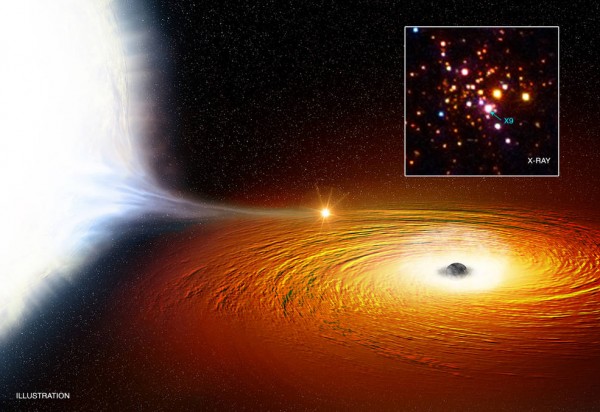By Ana Verayo, | March 14, 2017

Artist's illustration of a star found in the closest orbit known around a black hole in the globular cluster named 47 Tucanae. (NASA/CXC/M.Weiss)
A galaxy some 14,800 light years away from Earth apparently hosts not only planets orbiting its host star, but also a black hole. Scientists consider this discovery as truly unique, as this binary system includes not two stars, but one white dwarf star and a black hole.
This binary system known as X9 is located inside the Milky Way galaxy. In this new study, astronomers were able to obtain new observations courtesy of the NASA Chandra X-ray Observatory and NASA NuSTAR space telescopes along with the CSIRO's (Commonwealth Scientific and Industrial Research Organisation) Telescope Compact Array.
Like Us on Facebook
New observational data revealed that the white dwarf star could complete a single orbit around the black hole in 28 minutes. More specifically, NASA's Chandra X-ray Observatory was able to detect fluctuations in X-ray brightness around this galaxy. The distance between the white dwarf and the black holes are so close that it is estimated to be more twice as close as the distance between the Earth and the moon.
According to the lead author of the study, Arash Bahramian from the University of Alberta and Michigan State University, this white dwarf is so close to this black hole that stellar material is being sucked away from the star. Bahramian said that it is only a matter of time before the star collapses into the black hole, but astronomers suggest that the white dwarf will remain in its current orbit.
According to James Miller-Jones of Curtin University and the International Centre for Radio Astronomy, right now the star is losing fuel as this black hole has been feeding on it for tens of millions of years. The team predicts that this star will lose the majority of its stellar mas and its orbit will become wider and even more distant since more mass is lost.
It's been puzzling for astronomers for such a very close binary system to exist, even more so with a black hole. Theories suggest that this black hole probably collided into a red giant star that sucked in its gasses and left the star's core as a white dwarf. The black hole's gravity is so strong that this binary system emits gravitational waves, which ultimately creates a very tight orbit and pulls in the remaining material of this star.
This new study will be published in the Monthly Notices of the Royal Astronomical Society.
-
Use of Coronavirus Pandemic Drones Raises Privacy Concerns: Drones Spread Fear, Local Officials Say

-
Coronavirus Hampers The Delivery Of Lockheed Martin F-35 Stealth Fighters For 2020

-
Instagram Speeds Up Plans to Add Account Memorialization Feature Due to COVID-19 Deaths

-
NASA: Perseverance Plans to Bring 'Mars Rock' to Earth in 2031

-
600 Dead And 3,000 In The Hospital as Iranians Believed Drinking High-Concentrations of Alcohol Can Cure The Coronavirus

-
600 Dead And 3,000 In The Hospital as Iranians Believed Drinking High-Concentrations of Alcohol Can Cure The Coronavirus

-
COVID-19: Doctors, Nurses Use Virtual Reality to Learn New Skills in Treating Coronavirus Patients







